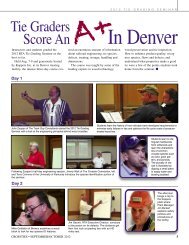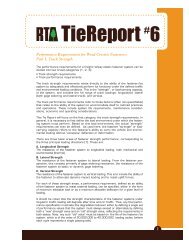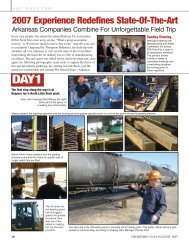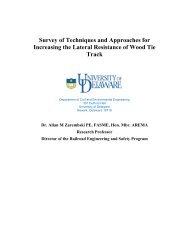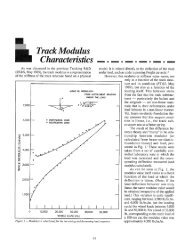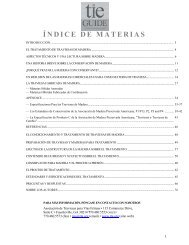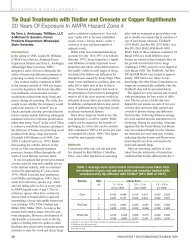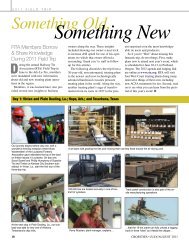New VICTOR Fastening System - Railway Tie Association
New VICTOR Fastening System - Railway Tie Association
New VICTOR Fastening System - Railway Tie Association
You also want an ePaper? Increase the reach of your titles
YUMPU automatically turns print PDFs into web optimized ePapers that Google loves.
PANDROL Introduces <strong>New</strong> <strong>VICTOR</strong> <strong>Fastening</strong> <strong>System</strong>By Alison MitchellBridgeport, N.J.-based PANDROLUSA LP is introducing its new VIC-TOR fastening system, which isdesigned to accommodate high axleloads on wood ties. The <strong>VICTOR</strong>system combines the durability of anAmerican <strong>Railway</strong> Engineering andMaintenance of Way <strong>Association</strong>(AREMA) tieplate with the benefitsof PANDROL’s existing line ofresilient rail fasteners.PANDROL USA Vice President ofEngineering Bob Coats said that severalrailroad conditions came together tocreate the need for a superior fasteningsystem. In his presentation at the 2003<strong>Railway</strong> <strong>Tie</strong> <strong>Association</strong> Convention inCharleston, S.C., Coats explained thathigher locomotive horsepower, dynamicbreaking, more MGTs per year, larger railsections and tie strength variation ledindustry experts to consider developing anew heavy haul tieplate design.Railroad officials developed a set ofdesign specifications for the new heavyhaul tieplate. The most critical of thesespecifications were maximum bearingarea contact with the tie, increased bearingarea asymmetry toward the field side,a clip housing that is centered on thetieplate, space for four screw spikes andtwo cut spikes, and, last but not least, again in economics over a cast plate.PANDROL engineers in their U.S. officeset to work on creating a new product thatwould fulfill these requirements. The resultis the <strong>VICTOR</strong> system, a new rolled steeltieplate system for wood ties that usesdurable, proven AREMA tieplates, whichhave a flat bottom with a 37 percentincrease in bearing area over existingtieplates for resilient fasteners. “Previously,we had rolled steel tieplates that did nothave a flat bottom and so they lost a lot ofbearing area. The <strong>VICTOR</strong> systememerged to meet the needs of today’s heavyhaul environment,” Coats said.According to PANDROL USAManager of Engineering Bill Geissele, the<strong>VICTOR</strong> system is flexible, as it is easilyconfigured for different tieplate profilesand clip styles. It is also economicalbecause it is competitive in cost to a castductile iron tieplate. Flat-bottomed16<strong>VICTOR</strong> tieplates, such as the one shown above, featurespace for four screw spikes and two cut spikes.AREMA tieplates provide maximumbearing area, while the use ofPANDROL’s fasteners provides all theadvantages railroads expect from resilientfasteners: holding power, prevention ofrail rollover and reduced maintenance.Product DevelopmentFor years there has been a desire todevelop a product such as the <strong>VICTOR</strong>system that couples rolled steel tieplateswith resilient rail fasteners, Geissele said.PANDROL’s <strong>VICTOR</strong> system is designedto work with its existing line of resilientrail fasteners, including the eClip,above, and the FASTCLIP, right.Yet, no company had been able tofind an economical way to producethem. “The process of creating rolledsteel tieplates is extremely economical,and the plates are strong anddurable. However, the geometry ofrolled steel tieplates must be kept verysimple due to the nature of the rollingmanufacturing process,” Geissele said,explaining that more complicated geometryis required for tieplates utilizingresilient fasteners.“Traditionally, if a tieplate designrequired a resilient fastener the onlyoption was to cast the tieplates, usuallyout of ductile iron. With a cast plate,it is easy to produce the complicatedgeometry necessary to mount aPANDROL clip. But, these casttieplates cannot be as economicallyor efficiently produced as a rolledsteel tieplate,” he said. “In order fora cast tieplate to approach the costof a rolled steel tieplate, the weightand number of cores in the castingprocess must be reduced. This constrainsthe most economical casttieplate to a design with a significantreduction in strength andrequires many hollow intrusions into thebottom of the tieplate, which lowers bearingarea and increases the tendency of thetieplate to cut into the wood crosstie.”Coats explained that the size of atieplate’s bearing area is important to theoverall safety of the railroad. “If atieplate’s bearing area is too small, it willwear into the tie. A plate with more bearingarea will allow more tie life and willkeep gage consistent by preventing railspreading.”PANDROL engineers concludedthat the solution was to take rolledsteel tieplates and add the complicatedgeometry of the cast tieplates in theform of lightweight, cast ductile ironshoulders. “We adapted an AREMArolled steel tieplate to the PANDROLFASTCLIP, PANDROL eClip andSafelok III resilient rail fasteners,”Geissele said. “The AREMA tieplates area strong, proven design, and our new systemis an economical way to use platesthat already existed.”The cast ductile iron shoulders PAN-DROL attaches to the AREMA tieplatesare easy to cast and only add nominalweight to the tieplate.CROSSTIES • JANUARY/FEBRUARY 2004
How The Ductile Iron ShouldersAre Attached To The Rolled Steel<strong>Tie</strong>platesPANDROL uses a proprietary cold forgingmethod called SWAGE to attach the castshoulders to the rolled steel tieplates. “Inthe beginning design stages we evaluatedthe different methods to attach a shoulderto a tieplate, including bolting, weldingand riveting,” Geissele said. “To bolt theshoulders on we would have to drill holes,thread the holes, supply bolts, purchase thedrill bits, actually bolt them on, etc., whichis not economically viable. The same principleholds for welding, except that therolled steel tieplates and the shoulders containa lot of carbon, which makes them difficultto weld.”The SWAGE method of attaching castshoulders to tieplates requires no extracomponents such as bolts, rivets or weldfiller. The plate and two shoulders areplaced in a large forging press where a sectionof the tieplate is forced under highpressure into a groove in the shoulder,locking the shoulder and tieplate together.This process is done “cold” or below there-crystallization point of the metal. “Atthe steel mill, rolled tieplates come out ofthe final form rolls and shear press at about1,500 degrees Fahrenheit, then they are leftto cool down and sit in storage until anopportune time for assembly,” Geisselesaid. “The plates and shoulders are thenbrought to the forge press where theSWAGE process locks the shoulder andtieplate together at room temperature.“Much research on the cold forgingprocess was done by the Germans duringWorld War II where they used the processto produce munitions such as artillery shellcasings and machine gun barrels. Althoughthe process is still used in certain industries,is has fallen out of favor as theinvestment casting process has takenover in the manufacture of many precisionmetal components,” he said.Geissele explained that during a coldforging operation, the applied shearstresses must exceed the yield strengthof the metal. Once the yield strength isexceeded, plastic flow of the metaloccurs. On a micro-scale, individualgrains acquire and retain distortionscorresponding to the overall distortionof the component on a macro-scale. Asthe distortions of individual grainsincrease, the resistance to deformationalso increases and the metal progressivelywork hardens.“We used this behavior of metals underhigh pressure to our advantage in developingthe SWAGE process. The steel of about.45 percent carbon used in AREMAtieplates behaves very well in the limitedplastic deformation needed to lock theshoulder in place,” he said.To understand the process, Geissele suggestedvisualizing a tieplate with a roundhole of approximately 1-inch diameterpunched on the centerline of the plate justpast the raised bosses next to the rail seat,as shown below.CROSSTIES • JANUARY/FEBRUARY 2004 17
A ductile iron shoulder that has a protrudinground stem is placed on top of theplate with its stem inserted into the hole,as shown below.displaced by the penetrator fills the groovein the shoulder stem and positively locksthe shoulder in place, such as below.from the tooling and is ready for installationin track. The process is fast, requiresno extra components other than the tieplateand shoulder, and creates no waste.The shoulder stem has an annulargroove cast into it that has a profiledesigned to maximize the strength of thestem near the groove in response to a loadapplied along the stem centerline.The tieplate and shoulder are placed onsupporting tooling in the forge press andthe press is stroked to bring the toolingtogether (below).During the press stroke, a hardened steel“penetrator” is forced into the bottom of thetieplate, as shown above. The penetrator isof a hollow, circular profile that encompassesthe area near the shoulder stem. Asthe penetrator enters the tieplate, metal iscompressed until it plastically deforms andbegins to press against the stem. As themetal presses against the stem, it will flowinto the annular groove and exert a force onthe sides of the groove, as seen below.Since the shoulder is constrained in thetieplate direction but unconstrained in thepenetrator direction, the shoulder stem willslightly elongate. This elongation is verysimilar to the elongation produced in a boltdue to the tightening of a nut.After the completion of the press strokethe impression of the penetrator is left inthe bottom of the tieplate and the metal18Not only does the tieplate metal in thegroove keep the shoulder in place but alsothe elongation of the stem produces afavorable compression stress at the surfacewhere the shoulder meets the top of thetieplate. This compressive stress must firstbe reversed before the shoulder can beeven slightly pulled from the surface of thetieplate.According to Geissele, the <strong>VICTOR</strong>SWAGE operation will meet or exceedAREMA specifications for pullout strengthon a shoulder in a concrete tie. AREMAminimum specifications for pullout strengthon a shoulder in a concrete tie is 12,000 lbf,meaning that about six tons are required topull the shoulder from a concrete tie.“We have seen consistent pulloutstrengths of 23,000 pounds for a <strong>VICTOR</strong>shoulder. Not only is the joint produced bythe SWAGE method stronger than a shoulderin a concrete tie, but the design of anAREMA tieplate with raised bosses alongthe railseat forces much of the rail lateralload into the tieplate, not on the <strong>VICTOR</strong>shoulder. In a concrete tie, the shouldersees almost 100 percent of the lateralload,” he said.After just one stroke of the forgingpress, a <strong>VICTOR</strong> assembly is removedWant more information from Crossties’ advertisers? Simply FAX us this request and we will passit along to the advertiser. A response will be on its way to you in a jiffy!FAX TO (251) 968-4532Product Testing And DetailsHaving been researched, designed anddeveloped at the Bridgeport plant, the<strong>VICTOR</strong> system is currently available fortrack installation. “We expect to have thesystem in widespread commercial use thisyear,” Coats said.Testing of resilient rail fastening systemshas also been ongoing at theTransportation Technology Center Inc. inPueblo, Colo. Experiments there with 39-ton axle loads have shown a five-folddecrease in gage widening when usingresilient fasteners on wood ties, whichgives strength and credence to the need fora system such as <strong>VICTOR</strong>.When using the <strong>VICTOR</strong> system, railroadswill be able to choose betweenPANDROL’s FASTCLIP, eClip andSafelok III fastening systems. Additionally,<strong>VICTOR</strong> comes with a ROLLBLOCKoption, which PANDROL has designed toeliminate rail rollover.Currently, tieplates are being rolled atthe Arkansas Steel Associates (ASA) millin <strong>New</strong>port, Ark. <strong>VICTOR</strong> plates are beingassembled at the Southwest SteelProcessing forge shop located at ASA.“We only have one mill in the UnitedStates making the tieplates at this time,”Coats said. “But we’ll be able to supply theNorth American market from this plant.”For more information on PANDROLUSA and its products and services, visitwww.pandrolusa.com. §❏ Arizona Pacific Wood Preserving ......................................................Pg. 9❏ Brewer, Inc..........................................................................................Pg. 9❏ Burke-Parsons-Bowlby ....................................................................Pg. 24❏ Chemstar ..........................................................................................Pg. 11❏ Koppers Industries..............................................................................Pg. 2❏ Pandrol USA ....................................................................................Pg. 23❏ P.T. O’Malley Lumber Co. Inc...........................................................Pg. 10❏ Railworks Products Inc.......................................................................Pg. 5❏ Seaman Timber Company................................................................Pg. 17❏ Thompson Industries Inc. ..................................................................Pg. 8❏ Trans Canada Wood Products Ltd. ..................................................Pg. 11❏ Trus Joist ..........................................................................................Pg. 13❏ Webster Wood Preserving................................................................Pg. 15Your NameCompanyAddressCity State ZipTelephoneFaxFAX ITCROSSTIES • JANUARY/FEBRUARY 2004



